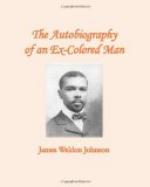All this while I was gathering material for work, jotting down in my note-book themes and melodies, and trying to catch the spirit of the Negro in his relatively primitive state. I began to feel the necessity of hurrying so that I might get back to some city like Nashville to begin my compositions and at the same time earn at least a living by teaching and performing before my funds gave out. At the last settlement in which I stopped I found a mine of material. This was due to the fact that “big meeting” was in progress. “Big meeting” is an institution something like camp-meeting, the difference being that it is held in a permanent church, and not in a temporary structure. All the churches of some one denomination—of course, either Methodist or Baptist—in a county, or, perhaps, in several adjoining counties, are closed, and the congregations unite at some centrally located church for a series of meetings lasting a week. It is really a social as well as a religious function. The people come in great numbers, making the trip, according to their financial status, in buggies drawn by sleek, fleet-footed mules, in ox-carts, or on foot. It was amusing to see some of the latter class trudging down the hot and dusty road, with their shoes, which were brand-new, strung across their shoulders. When they got near the church, they sat on the side of the road and, with many grimaces, tenderly packed their feet into those instruments of torture. This furnished, indeed, a trying test of their religion. The famous preachers come from near and far and take turns in warning sinners of the day of wrath. Food, in the form of those two Southern luxuries, fried chicken and roast pork, is plentiful, and no one need go hungry. On the opening Sunday the women are immaculate in starched stiff white dresses adorned with ribbons, either red or blue. Even a great many of the men wear streamers of vari-colored ribbons in the buttonholes of their coats. A few of them carefully cultivate a forelock of hair by wrapping it in twine, and on such festive occasions decorate it with a narrow ribbon streamer. Big meetings afford a fine opportunity to the younger people to meet each other dressed in their Sunday clothes, and much rustic courting, which is as enjoyable as any other kind, is indulged in.
This big meeting which I was lucky enough to catch was particularly well attended; the extra large attendance was due principally to two attractions, a man by the name of John Brown, who was renowned as the most powerful preacher for miles around; and a wonderful leader of singing, who was known as “Singing Johnson.” These two men were a study and a revelation to me. They caused me to reflect upon how great an influence their types have been in the development of the Negro in America. Both these types are now looked upon generally with condescension or contempt by the progressive element among the colored people; but it should never be forgotten that it was they who led the race from paganism and kept it steadfast to Christianity through all the long, dark years of slavery.




